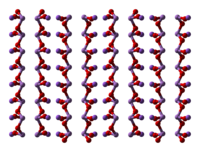Sodium arsenite
 |
|
| Names | |
|---|---|
|
IUPAC name
sodium arsenite
|
|
| Other names
sodium arsenate(III)
|
|
| Identifiers | |
|
3D model (Jmol)
|
|
| ChEBI | |
| ECHA InfoCard | 100.029.154 |
| EC Number | 232-070-5 |
| KEGG | |
|
PubChem CID
|
|
|
|
|
|
| Properties | |
| NaAsO2 | |
| Molar mass | 129.911 g/mol |
| Appearance | white or grayish powder hygroscopic |
| Density | 1.87 g/cm 3 |
| Melting point | 550 °C (1,022 °F; 823 K) decomposes |
| 156 g/100 mL | |
| Solubility | slightly soluble in alcohol |
| Hazards | |
| Safety data sheet | External MSDS |
| R-phrases (outdated) | R23,R25,R45 |
| NFPA 704 | |
| Lethal dose or concentration (LD, LC): | |
|
LD50 (median dose)
|
41 mg/kg (rat, oral) |
| US health exposure limits (NIOSH): | |
|
PEL (Permissible)
|
[1910.1018] TWA 0.010 mg/m3 |
|
REL (Recommended)
|
Ca C 0.002 mg/m3 [15-minute] |
|
IDLH (Immediate danger)
|
Ca [5 mg/m3 (as As)] |
|
Except where otherwise noted, data are given for materials in their standard state (at 25 °C [77 °F], 100 kPa).
|
|
|
|
|
| Infobox references | |
Sodium arsenite usually refers to the inorganic compound with the formula NaAsO2. Also called sodium meta-arsenite, it is the sodium salt of arsenous acid. Sodium arsenite also ) Na3AsO3, called sodium ortho-arsenite. The compounds are colourless solids.
A mixture of sodium meta-arsenite and sodium ortho-arsenite is produced by treating arsenic trioxide with sodium carbonate or sodium hydroxide. Sodium arsenite is amorphous, typically being obtained as a powder or as a glassy mass. The compound consists of the polymer [AsO2]n−
n associated with sodium cations, Na+. The polymer backbone has the connectivity -O-As(O−)-.
Sodium arsenite can be inhaled or absorbed through the skin. Along with its known carcinogenic and teratogenic effects, contact with the substance can yield symptoms such as skin irritation, burns, itching, thickened skin, rash, loss of pigment, poor appetite, a metallic or garlic taste, stomach pain, nausea, vomiting, diarrhea, convulsions, decreased blood pressure, and headache. Severe acute poisoning may lead to nervous system damage resulting in weakness, poor coordination, or “pins and needles” sensations, eventual paralysis, and death.
...
Wikipedia


